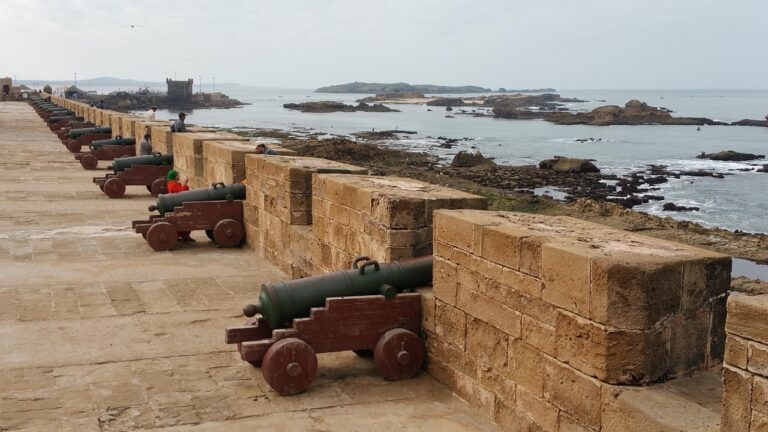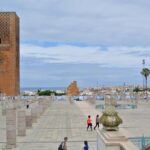Essaouira Guide
Essaouira is a fortified port city on the Atlantic coast. This peaceful town boasts an incredible location, combining gastronomy, relaxation, and nature!
Essaouira , also called “Amogdul” (the well-guarded) in Berber, “Mogadur” in Spanish or “Mogador” in French, is a port city in Morocco . Built on the Atlantic coast, it now has more than 70,000 inhabitants and is also the capital of the province that bears the same name.
Presentation
Essaouira is located on the Atlantic coast of Morocco . More precisely, it is located 173 km north of the city of Agadir and 176 km west of Marrakech . To get there, from Casablanca , you have to go south and travel 360 km.
This city was built on a peninsula exposed to the trade winds. Thus, throughout the year, the temperature is pleasant and constant (around 25°). In summer, unlike other cities in the country such as Agadir , Safi or Casablanca , it is cooler in Essaouira .
History tells us that the construction of this city was initiated by Sultan Mohammed ben Abdallah in the 1760s. To build it, this illustrious figure called upon several famous architects, including Théodore Cornut . It was the latter who drew up the plan of the city in order to make it a city adapted to the needs of foreign merchants, in accordance with the Sultan’s requirements.
Théodore Cornut , a student of Vauban and known for having already built many strongholds in Languedoc-Roussillon , is in fact the one who made sure that Mogador (as the Portuguese called it) became Essaouira or literally “the fortified place”.
This architect endowed the city with sumptuous ramparts facing the ocean and is also responsible for the surprising streets of its medina. Cornut had these streets built according to a rectilinear plan while ensuring that they were provided with wide arteries intersecting at right angles.
When Essaouira was completed, it began to develop into the most important commercial port in the country. Between the end of the 18th century and the first half of the 19th century, Essaouira even became the diplomatic capital of Morocco . In addition , it was known for being a multicultural and artistic city, which is still the case today.
It is important to know that between the end of the 19th century and the beginning of the 20th century, Essaouira experienced a rather dark period. Indeed, it was bombed in 1844, then placed under French protectorate in 1912. It thus lost its importance to the point of losing its status as an international port and diplomatic capital of Morocco .
Nevertheless, since the end of the 20th century, Essaouira has experienced a rapid and spectacular renaissance. It has begun to shine again, particularly thanks to tourism and its cultural vocation. In 2001, its medina was listed as a UNESCO World Heritage Site , and since then, it has continued to attract tourists from all over the world.
It should be noted that before the Portuguese settled in the Essaouira region (from the 16th century) and built a fortress with ramparts there (in 1506), the area was already inhabited, and this, from Antiquity. Phoenicians, Berbers and Romans had already settled there at certain times.
Why visit Essaouira?
Today, there are a thousand and one reasons to visit this city, which has become a charming port and a popular seaside resort. These include, for example, the tranquility it offers or its enchanting landscapes dominated by three colors: white, blue, and ochre.
There is also gastronomy. Once in Essaouira , visitors will be able to discover and savor many typical dishes of the region. The menu will include, among others, tagine (a dish based on poultry and fish or vegetables stewed), méchoui (spit-roasted lamb) or pastilla (thin puff pastry stuffed with pigeon meat and almonds). Not to be forgotten: the famous honey cakes, feqqas with almonds or raisins, as well as the famous mint tea.
Another reason to visit Essaouira is that it offers optimal conditions for practicing various water sports. In fact, many windsurfing and kitesurfing enthusiasts go to this city to enjoy the winds that blow almost continuously in its bay. For your information, Essaouira is even the location of a stage of the Kitesurfing World Cup every year.
In short, there are plenty of reasons to visit Essaouira today . Watching cabinetmakers working with cedar near its ramparts, strolling along its beach on a dromedary or horse, welcoming its trawlers and seeing the fruits of their catch, admiring the sunset from the top of its walls are all other reasons to visit this city with its decidedly irresistible charm.
The different districts of Essaouira
The city of Essaouira is made up of many districts, including the Medina , the Dunes and Diabat.
The medina
This is where those looking to truly soak up the city’s unique atmosphere go. One of its advantages is that it’s close to the city walls, beaches, and port. Furthermore, there are plenty of accommodation options here, with something for every budget and taste.
Good to know : Motor vehicles are prohibited inside the medina. Those with large luggage are advised to opt for accommodation near Bab Sba’a, Bab Al Marsa, Bab Marrakech , and Bab Doukkala (the four gates of the old city).
Kasbah
Located southwest of the medina, this neighborhood is the oldest in the city. It extends all the way to Moulay Hassan Square . It is the historic heart of the medina. This is where visitors can best witness the unfolding of local life. Very lively and popular, Kasbah is also full of restaurants, cafes, museums, and galleries.
Chbanat
For its part, this district is located northeast of the Medina . Just like Kasbah , it is very lively and in its streets, visitors will have the opportunity to see many talented artists at work. In Chbanat , art galleries are countless, as are the houses with such a particular style.
Mellah
This neighborhood is located northwest of the medina. It is actually the old Jewish quarter of Essaouira . While walking through its narrow streets, visitors can see synagogues. Note that every year in September, many Jews flock to this place to honor Rabbi Haim Pinto . In fact, his tomb is located in the city cemetery.
The Dunes district
The Dunes district is located to the south, outside the medina walls. It is appreciated for its tranquility and especially its proximity to Tagharte beach. Because it is close to the ocean, this district is where water sports enthusiasts from all over the world meet. There are surfers, kitesurfers and windsurfers of all levels. The most experienced, on the other hand, generally go to Sidi Kaouki beach, about thirty kilometers from Essaouira . For beginners, the bay is ideal.
Diabat
Slightly further south from the city, Diabat is a small village. It is located in a protected natural area and is particularly famous for hosting Jimi Hendrix in the 1970s. It is even said that this rock star was inspired by this place to write one of his songs. Having fallen under the spell of Diabat , Jimi Hendrix is said to have considered buying the village.
What to see in Essaouira?
The port
Essaouira’s port was built at the foot of its ramparts. It is located at the very end of the long beach that borders the city. These days, maritime traffic is no longer as intense. However, in the port, visitors can see many colorful trawlers, most of them made using ancestral methods from teak and eucalyptus wood. If they arrive early in the morning, tourists can witness the daily routine of fishermen and fishmongers. They will have the chance to observe the fishing boats gathering around the docks and the fishmongers setting up their stalls.
At a certain time, holidaymakers will see the fish being hoisted onto the pontoon before being distributed among the vendors. If they wish, they can then buy sardines and mackerel, once these have been fried on the spot. In the port of Essaouira , the seagulls will also put on a show, screaming and not hesitating to come and plunder the fishermen’s stalls.
La square du port
This long platform once housed part of the city’s artillery. It served to protect the port of Essaouira from external attacks. It housed several bronze cannons bearing coats of arms. Today, visitors can still see the city’s motto, ” Barakat Mohammed ,” on the four sides of the structure’s dungeons. Inscribed on thuja plaques, it was used to seek the Prophet’s blessing for the city and its population.
Note that visitors will be able to access the corner tower overlooking the sqala. At the top of it, they will have the opportunity to admire not only the medina, but also the port, the bay and Diabat . Here again, the seagulls will be there, still screaming as much as they let themselves be carried by the winds. For your information, it was at the sqala of the port of Essaouira that Orson Welles filmed some of the scenes of his film “Othello”.
The ramparts
They are over 2 km long and, along with the batteries of the port, Mogador Island , and Diabat Beach, they formed one of Essaouira’s defenses. With their magnificent ochre color, these ramparts are among the structures that give this city its beauty. They even give it the air of a small Breton town.
It is important to know that the city walls are of two styles. In fact, part of its walls bear witness to the Arab influences on Essaouira , while others are proof that the place was under French influence for a certain time. The Cherifian-type walls will be recognizable by their stones having been coated with ochre plaster and flanked by square battlements. They will also be distinguished by their round doors. The European-type walls, on the other hand, were built without plaster and will be characterized by their wide patrol path, their vast watchtowers and their beveled battlements.
The Sidi Mohammed ben Abdallah Museum
Located on Laâlouj Street , this museum dedicated to the region’s artisanal customs and traditions is housed in a magnificent 19th-century merchants’ riad. It was actually the former seat of the town hall under the French protectorate. Tourists can admire several collections (archaeological discoveries, musical instruments, carpets, furniture, jewelry, weapons, etc.) gathered by the artist Boujemâa Lakhdar , the museum’s creator.
The medina
Since its creation in the 18th century, it has remained virtually unchanged. This is what earned it a UNESCO World Heritage Site designation. Visitors can wander through the narrow streets and discover a multitude of local crafts.
Of course, these are just a few examples of the places to see in Essaouira . Once there, visitors can also go to Bab el-Marsa (the Marine Gate), the Sqala of the Casbah , the Purpuraires Islands or explore the souks. Other places that are absolutely worth visiting are: the Marjana argan cooperative (20 minutes from Essaouira ), the Sidi M’Barek waterfalls (40 minutes from the city) and of course, Essaouira beach , one of the best in Morocco .
How to visit Essaouira?
Essaouira is a fairly small city. It’s entirely possible to tour it in a single day. The best way to explore it is to walk through its many streets and alleys. On foot, it’s easier to appreciate all the architectural details of the city, smell the different scents of spices or fish, and see how the locals live their daily lives. For those who want to leave the Medina and go a little further, walking is also an option. Otherwise, there are always taxis, which cost 7 dirhams, regardless of the route.





